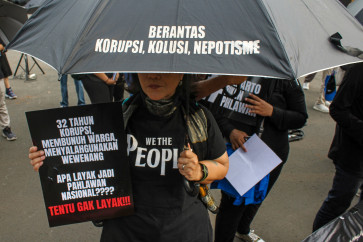Irrawaddy dolphins found in W. Kalimantan waters
For the first time ever, WWF-Indonesia and its partner, the Regional Office for Marine, Coastal & Resources Management Pontianak (BPSPL) have confirmed the existence of Irrawaddy dolphins, known as Orcaella brevirostris, in the Kubu Raya and Kayong Utara waters of West Kalimantan
Change text size
Gift Premium Articles
to Anyone

F
or the first time ever, WWF-Indonesia and its partner, the Regional Office for Marine, Coastal & Resources Management Pontianak (BPSPL) have confirmed the existence of Irrawaddy dolphins, known as Orcaella brevirostris, in the Kubu Raya and Kayong Utara waters of West Kalimantan.
The team also encountered a group of Indo-Pacific Humpback dolphins, known as Sousa chinensis, in the area, showing strong scientific evidence of the rich biodiversity in Kalimantan’s waters, which originate in the highlands of Borneo.
“Until now the presence of the Irrawaddy dolphin population in West Kalimantan waters was unknown, so we are excited with the results of this preliminary study and hope this will help to reveal information on the population and distribution of this unique species,” said Albertus Tjiu, WWF-Indonesia’s conservation biologist, one of the lead scientists on the study.
”The results of this study also indicate the importance of protecting the habitat of the dolphins, from the origins of the rivers in the heart of Borneo, to the lower rivers of the island, including the waterways of Batu Ampar mangrove and nypah forests, narrow straits and the coastal areas of Kubu Raya, West Kalimantan,” Albert said in a statement on Tuesday.
“The WWF calls on all companies that operate in West Kalimantan waters to apply sustainable practices in their businesses, and with regards to this dolphin study, to carefully look at their wood supply to avoid mangrove forest destruction,” said Albert.
“Kubu Raya and Kayong Utara waters are located downstream of Borneo in West Kalimantan. The conservation of forests in the heart of Borneo is considered critical to ensuring the proper protection of the Irrawaddy dolphins’ fresh water habitat and ecosystem,” said Tri Agung Rooswiadji, WWF-Indonesia’s Fresh Water Conservation Program coordinator. “As a unique species that lives in fresh, salt and brackish waters, this mammal serves as an indicator of the health of the water ecosystem in the area,” Tri Agung added.
“The dolphin survey in Kubu Raya and Kayong Utara waters is preliminary. We are hoping to continue studying the species in other rivers in Kapuas, Sejenuh and Mendawa river,” said Tri Agung. With comprehensive information on the population and habitat of the dolphin, it is expected that future policies on the protection of the species will be identified and implemented.









